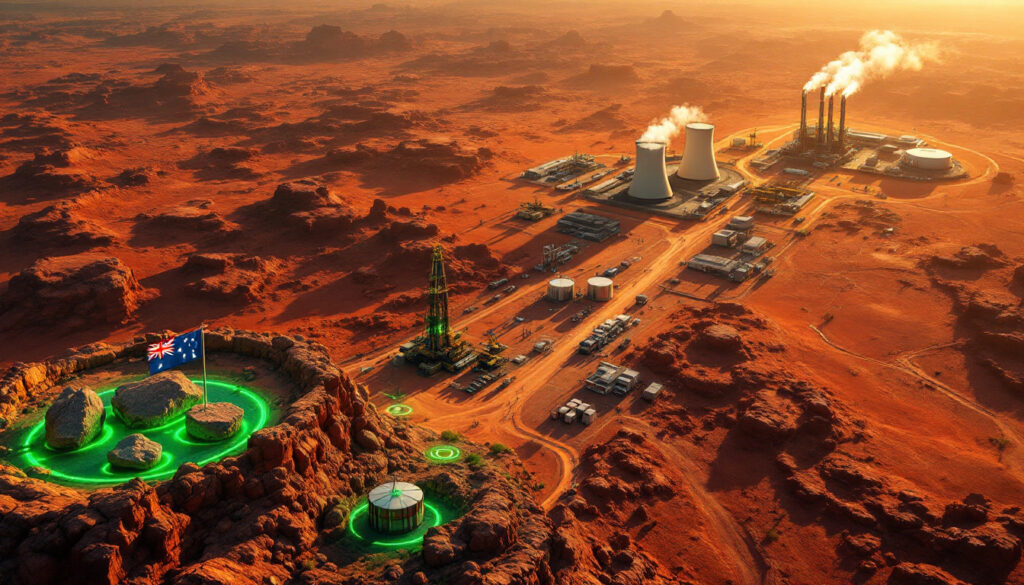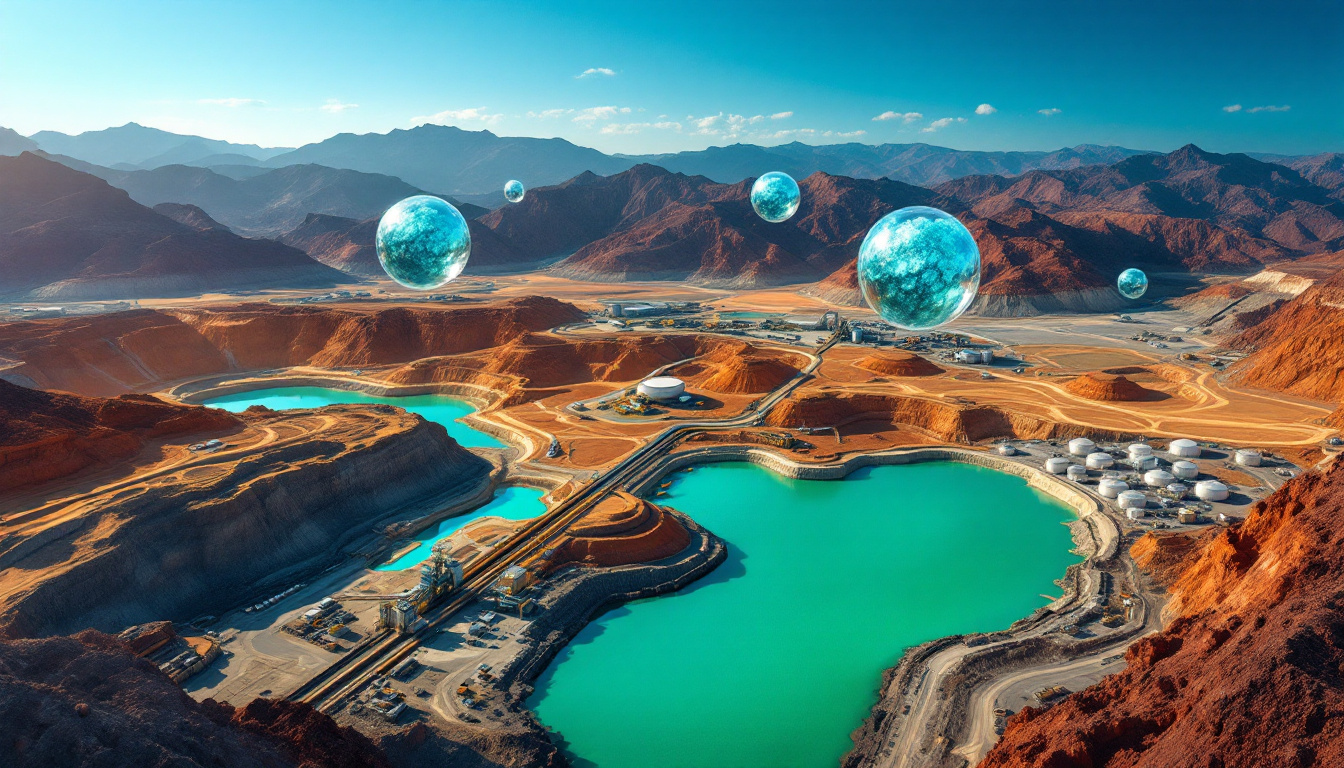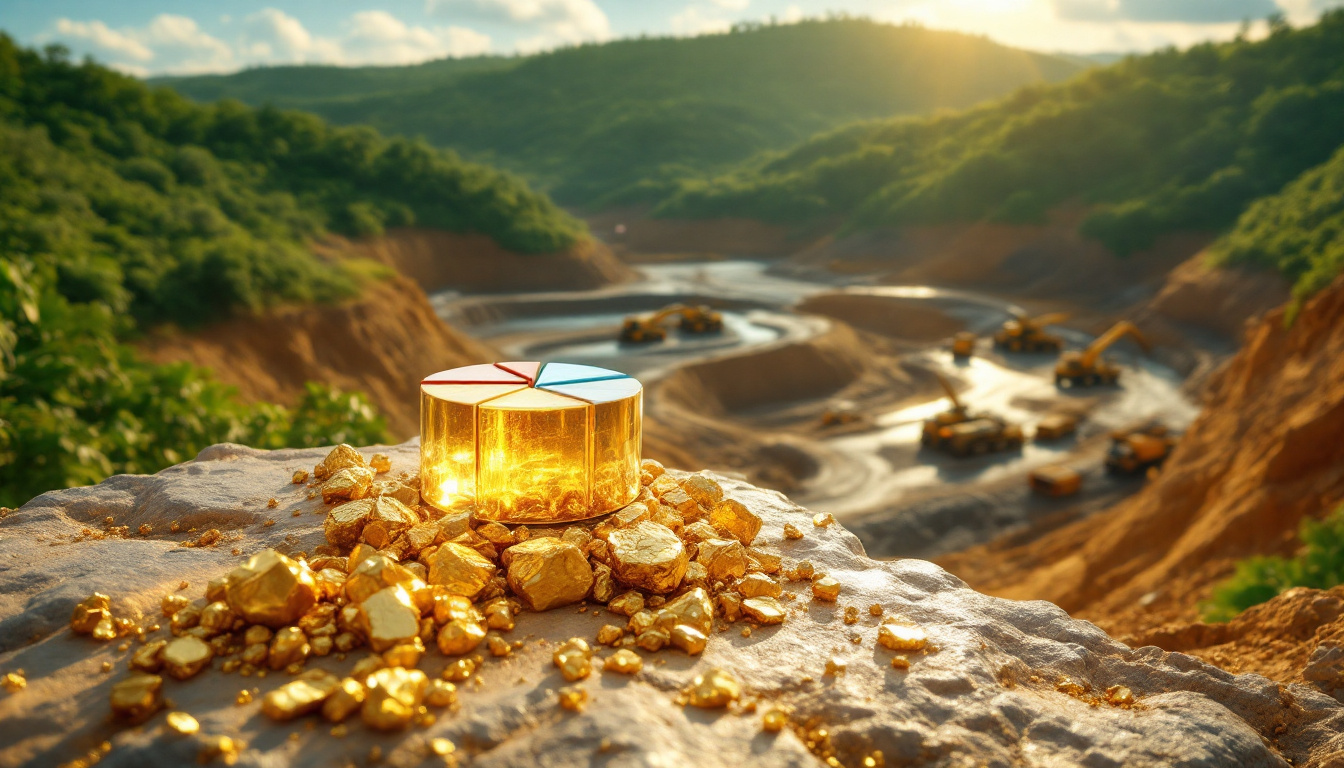What is the Current Status of Uranium Mining in Western Australia?
The Uranium Mining Ban in Western Australia
Western Australia's uranium mining sector remains in a state of suspended animation following the implementation of a mining ban by former Premier Mark McGowan in 2017. This policy reversal effectively halted the development of uranium projects that had been greenlit under the previous Liberal government's more favorable stance toward the industry.
The ban's timing was particularly strategic, coinciding with a period of depressed uranium prices in the aftermath of the Fukushima disaster, which minimized immediate economic backlash. Industry analysts have noted that this policy decision was partially motivated by internal Labor party politics, specifically to prevent voter migration to the Greens by appealing to the party's environmental wing.
"The uranium mining ban was a calculated political decision that has never been particularly popular with the broader WA population," notes one industry expert. "It was implemented during a uranium price trough when the economic impact would be less noticeable, but with prices now surging, the opportunity cost is becoming increasingly apparent."
Existing Uranium Projects in Western Australia
Despite the mining prohibition, several significant uranium projects remain in development limbo across the state. Companies like Cauldron Energy maintain exploration-ready assets that could quickly transition to production should the regulatory environment change. These projects collectively represent one of Australia's untapped resource opportunities.
The current regulatory framework presents an interesting contradiction: while mining is prohibited, exploration activities and resource definition work can still proceed. This has allowed companies to continue refining their understanding of deposit quality and extent, effectively positioning themselves for rapid deployment should the ban be lifted.
Western Australia's uranium resources are estimated to be substantial, with grades comparable to or exceeding those found in currently producing regions in South Australia. The known deposits represent just a fraction of the state's potential uranium resources, with geological indicators suggesting much broader distribution across the vast territory.
Why is Uranium Mining Important for Australia's Future?
Australia's Global Position in Uranium Resources
Australia sits atop the world's largest uranium reserves, estimated at approximately 28% of the global total. Despite this commanding resource position, Australia currently ranks as only the fourth-largest producer globally, with annual exports of around 5,000 tons primarily from South Australia's operations.
Western Australia's untapped uranium potential represents a significant opportunity to strengthen Australia's position in global markets. Current production comes exclusively from South Australia and the Northern Territory, with Western Australia and Queensland maintaining mining bans despite possessing substantial resources.
"Australia has the geological good fortune to possess the world's largest uranium reserves, yet we're not maximizing this strategic advantage," explains a mining sector analyst. "The current production of 5,000 tons annually could potentially double or triple if Western Australia's deposits were developed."
Economic Benefits of Uranium Mining
The economic case for uranium mining in Western Australia has strengthened considerably as traditional mining sectors face challenges. The iron ore industry, long Western Australia's economic cornerstone, faces uncertain long-term prospects as major customers like China develop alternative supply chains and transition their economies.
Uranium mining presents an opportunity for significant job creation, particularly valuable as sectors like nickel mining experience downturns. Industry projections suggest that opening Western Australia's uranium sector could create thousands of direct jobs and many more in supporting industries.
Revenue diversification presents another compelling argument. With uranium prices showing strong upward momentum, reaching over $100 per pound in 2023 after languishing below $30 for much of the previous decade, the economic calculus has shifted dramatically in favor of development.
Environmental Impact and Carbon Reduction
Perhaps counterintuitively, uranium mining offers substantial environmental benefits through its role in carbon reduction. Current Australian uranium exports power nuclear plants that offset approximately 200 million tons of carbon emissions annually—equivalent to about 40% of Australia's total national emissions of 450 million tons.
This emissions displacement effect could potentially increase dramatically if Western Australia and Queensland opened their uranium resources for development. Some analysts suggest that Australia could essentially achieve mathematical net-zero emissions through export offsets while developing domestic nuclear capabilities.
Uranium's unmatched energy density means that relatively small mining operations can produce material with enormous energy potential. One kilogram of uranium-235 can theoretically produce as much energy as 1,500 tons of coal, resulting in a remarkably small physical footprint compared to other energy resource extraction.
How Does Nuclear Waste Management Work in Australia?
Sandy Ridge Facility and Radioactive Waste Management
Western Australia hosts one of the world's most advanced radioactive waste management facilities at Sandy Ridge. This state-of-the-art installation was completed in approximately seven years—a remarkable achievement compared to the 40-50 years international experts typically estimate for similar projects.
The facility demonstrates Australia's capacity for world-class nuclear waste management, utilizing the region's geological stability and extremely low rainfall to create ideal storage conditions. Sandy Ridge represents one of the most complex regulatory approval processes for any project in Australia, meeting extraordinarily stringent environmental and safety requirements.
"The Sandy Ridge facility proves Australia can execute sophisticated nuclear projects efficiently and safely," notes a nuclear safety expert. "The project timeline of seven years versus the international norm of 40-50 years speaks to Australia's regulatory capability and engineering expertise."
Types of Radioactive Waste in Australia
Australia produces various forms of radioactive waste that require careful management. The medical sector generates significant volumes through diagnostic procedures and cancer treatments, with hospitals across the country regularly shipping materials to centralized facilities.
Industrial sources include scale from oil and gas industry maintenance operations, which can concentrate naturally occurring radioactive materials during extraction processes. The mineral sands industry, particularly active in Western Australia, produces materials requiring radiological management.
Consumer products like smoke detectors and exit signs contain small amounts of radioactive material that must be properly disposed of at end-of-life. While individually minimal, the aggregate volume requires systematic handling to ensure environmental protection.
Current Nuclear Facilities in Australia
Australia's nuclear capabilities extend beyond what many citizens realize. The country has operated three research reactors historically, with the current OPAL reactor at Lucas Heights (operated by ANSTO) in Sydney producing an astonishing 25% of the global Molybdenum-99 supply—a critical radioisotope used in medical diagnostic procedures.
This significant contribution to global nuclear medicine stands in stark contrast to Australia's limited nuclear energy development. The OPAL reactor represents world-class nuclear expertise and demonstrates Australia's capability to operate sophisticated nuclear facilities safely and effectively.
The disconnect between Australia's world-leading position in nuclear medicine production and its reluctance to develop nuclear energy creates an interesting paradox that increasingly attracts policy attention as energy security concerns grow.
What Are the Regulatory and Safety Aspects of Uranium Mining?
Western Australia's Existing Regulatory Framework
Western Australia already possesses sophisticated radioactive monitoring and management systems thanks to its thriving mineral sands industry. The state has accumulated approximately 40 years of data on handling naturally occurring radioactive materials, creating a robust foundation for uranium mining regulation.
This existing expertise and regulatory infrastructure could be readily adapted to uranium mining operations, providing a significant head start compared to jurisdictions beginning from zero. The state's radiation management protocols are considered among the world's most advanced, with comprehensive monitoring and reporting systems.
"Western Australia's radiation management capabilities are world-class," explains a radiation safety officer. "The systems developed for the mineral sands industry over four decades provide a turnkey framework that could be applied to uranium mining with minimal modification."
Nuclear Security and Safeguards
Australia's Safeguards and Non-proliferation Office (ASNO) represents the global gold standard in nuclear material tracking and security. This often-overlooked agency maintains meticulous accountability for every gram of Australian-obligated nuclear material throughout its lifecycle.
ASNO's comprehensive systems for detecting and recovering any lost radioactive materials have been demonstrated in recent incidents where missing industrial sources were rapidly located and secured. This capability underpins Australia's reputation as a responsible nuclear state and uranium supplier.
The organization's expertise extends to international nuclear safeguards, with Australian personnel frequently serving in leadership positions within the International Atomic Energy Agency (IAEA) and other global nuclear governance bodies.
Safety Comparisons with Other Industries
Many nuclear industry professionals consider radiation hazards less concerning than other industrial risks they encounter. Chemical hazards, which unlike radioactive materials never decay and diminish, often present more persistent environmental threats.
High-voltage electrical systems in mining operations frequently require more extensive protective equipment than many radiation environments. The ability to detect radiation with sensitive monitoring equipment provides a safety advantage compared to invisible chemical threats that may lack detection systems.
"In my thirty years in industrial safety, I've always found it easier to protect workers from radiation than from chemical hazards," notes one safety engineer. "Radiation is straightforward to detect and shield against, while chemicals can present multiple exposure pathways and persistent environmental impacts."
How Does Nuclear Energy Compare to Other Energy Sources?
Nuclear Energy Economics
The economic analysis of nuclear versus renewable energy continues to evolve as grid systems become more complex. While simple levelized cost comparisons often favor wind and solar, full system cost analyses that include storage, transmission, and reliability factors may favor nuclear inclusion in balanced energy portfolios.
Recent studies from California's grid operator suggest that incorporating nuclear power into predominantly renewable systems can actually reduce overall system costs by addressing intermittency issues and reducing the need for expensive backup generation and storage.
Current economic models often fail to account for all costs associated with renewable-heavy grids, particularly the expense of maintaining dispatchable backup capacity and massive transmission networks. Nuclear plants, by contrast, provide reliable baseload power with minimal land requirements and predictable lifecycles.
Waste Comparison Between Energy Sources
All energy sources produce waste streams, though these vary dramatically in volume, toxicity, and longevity. Nuclear waste receives disproportionate attention despite its relatively small volume compared to other energy industries.
For perspective, 60 years of nuclear power providing 20% of US electricity has produced waste that would fit within a large retail store. Meanwhile, coal plants produce more radioactive waste annually through fly ash than the entire nuclear industry, albeit at lower concentrations.
Renewable technologies also generate significant waste streams that receive less public scrutiny. Solar panel disposal presents growing challenges due to heavy metals content, while wind turbine blades require specialized handling at end-of-life due to their composite materials.
Reprocessing and Recycling of Nuclear Fuel
Conventional nuclear reactors utilize only about 5-7% of uranium's energy potential, leaving spent fuel with approximately 90% of its original energy content intact. This material can be reprocessed and recycled into mixed oxide (MOX) fuel for further power generation.
Australia currently sends its small volume of high-level waste from the OPAL reactor to France for reprocessing, demonstrating the viability of international solutions for waste management. This approach reduces waste volume while recovering valuable materials.
Advanced reactor designs, particularly breeder reactors, can further utilize the energy content in processed fuel, potentially extending uranium resources by orders of magnitude and reducing waste volumes significantly.
What is the Future Outlook for Uranium Mining in Western Australia?
Political Landscape and Potential Policy Changes
Industry observers increasingly believe Western Australia's uranium mining ban could be lifted sooner than widely expected. The policy's current wording—that the government has "no current intention to change"—deliberately leaves room for future shifts without requiring dramatic policy reversals.
Both sides of government have begun engaging more seriously with the uranium question as energy security concerns mount and global nuclear expansion accelerates. The ban, initially implemented during a period of low uranium prices and waning nuclear interest, now faces a dramatically different global context.
International pressure from AUKUS partners may accelerate policy reconsideration as Australia develops nuclear submarine capabilities requiring specialized nuclear expertise and potentially domestic fuel cycle components.
Global Demand for Uranium
The international uranium market faces fundamental supply challenges as Western nations seek to reduce dependence on Russian sources while simultaneously expanding nuclear capacity. Current production levels fall significantly short of demand, with price increases reflecting growing supply concerns.
The AUKUS submarine deal creates additional strategic considerations for Australia's uranium policy. The country will operate nuclear-powered submarines utilizing highly enriched uranium fuel, creating potential inconsistencies in maintaining mining bans while developing advanced nuclear capabilities.
Diplomatic pressure from allies receiving Australian nuclear submarines may influence domestic uranium policy, as these partners question the logic of Australia prohibiting uranium mining while supplying nuclear-powered military assets.
Public Engagement and Advocacy
Organizations like Nuclear for Australia have begun building public support for broader nuclear development, including uranium mining. These efforts focus on education and awareness, addressing decades of misunderstanding and misinformation about nuclear technologies.
Growing recognition of uranium mining as part of a broader energy transition strategy has begun shifting public perception. The potential role of nuclear power in supporting reliable, low-carbon electricity systems increasingly resonates as grid stability concerns mount.
Increased public awareness that Western Australia maintains a uranium mining ban represents the first step toward potential policy change. Many Western Australians remain unaware of the prohibition, with advocacy groups focusing initially on basic education about the current regulatory landscape.
Frequently Asked Questions About Uranium Mining in Western Australia
Is uranium mining dangerous for workers and communities?
Modern uranium mining follows stringent safety protocols and radiation protection standards that effectively minimize risks to workers and surrounding communities. Western Australia already has extensive experience managing radioactive materials through its mineral sands industry, with sophisticated monitoring systems and safety protocols.
Radiation exposure in modern uranium mines is typically well below regulatory limits and often comparable to natural background radiation levels in many areas. Comprehensive monitoring ensures any potential issues are identified and addressed before significant exposure occurs.
Many industry professionals consider conventional mining hazards like vehicle accidents, falls, and mechanical failures more concerning than radiation risks. The mining industry's overall safety record has improved dramatically in recent decades through improved practices and regulatory oversight.
How would lifting the uranium mining ban benefit Western Australians?
Removing the uranium mining prohibition would create significant employment opportunities during a period when traditional mining sectors face challenges. These jobs would span the spectrum from high-skill technical positions to support roles across regional communities.
The state government would benefit from revenue diversification through royalties and taxes, reducing dependence on iron ore exports and creating greater economic resilience. Uranium projects could revitalize mining communities experiencing downturns in other commodities.
Western Australia's contribution to global decarbonization efforts would increase substantially as its uranium powers clean energy generation worldwide. This aligns with the state's growing emphasis on sustainability and ESG challenges across its resource industries.
What happens to uranium once it's mined in Australia?
Australian uranium undergoes meticulous tracking throughout the entire fuel cycle under the supervision of the Australian Safeguards and Non-proliferation Office (ASNO). This comprehensive monitoring ensures the material is used exclusively for peaceful purposes in countries with appropriate nuclear cooperation agreements.
After mining and initial processing, uranium is exported as yellowcake (U₃O₈) for conversion, enrichment, and fuel fabrication overseas. Australian uranium supplies power plants that collectively offset approximately 200 million tons of carbon emissions annually—equivalent to 40% of Australia's national emissions.
The material's journey from mine to reactor typically spans several years, with multiple processing stages occurring in different countries. This international fuel cycle creates a robust network of checks and balances that prevent diversion for non-peaceful purposes.
How does uranium mining compare environmentally to other types of mining?
Uranium mining's environmental footprint is relatively modest compared to many bulk commodity operations due to the extraordinarily high energy density of the material. A single uranium mine can produce fuel equivalent to multiple massive coal mines, requiring significantly less land disturbance.
Modern practices include progressive rehabilitation and strict environmental controls that minimize ecosystem impacts. Water management receives particular attention, with comprehensive monitoring systems ensuring groundwater protection throughout operations and after closure.
The lifecycle carbon emissions of nuclear power, including mining, processing, and plant construction, are comparable to renewable energy sources at approximately 12g CO₂/kWh. This makes uranium mining an environmentally competitive option when considering the complete energy production chain, particularly in light of Australia's economic challenges and the growing global critical minerals race.
Want to Stay Ahead of Major Mineral Discoveries?
Don't miss the next market-moving mineral discovery announcement on the ASX! Experience real-time alerts on significant discoveries across 30+ commodities with Discovery Alert's proprietary Discovery IQ model. Visit our discoveries page to see the historic returns generated from major mineral finds and start your 30-day free trial today.




